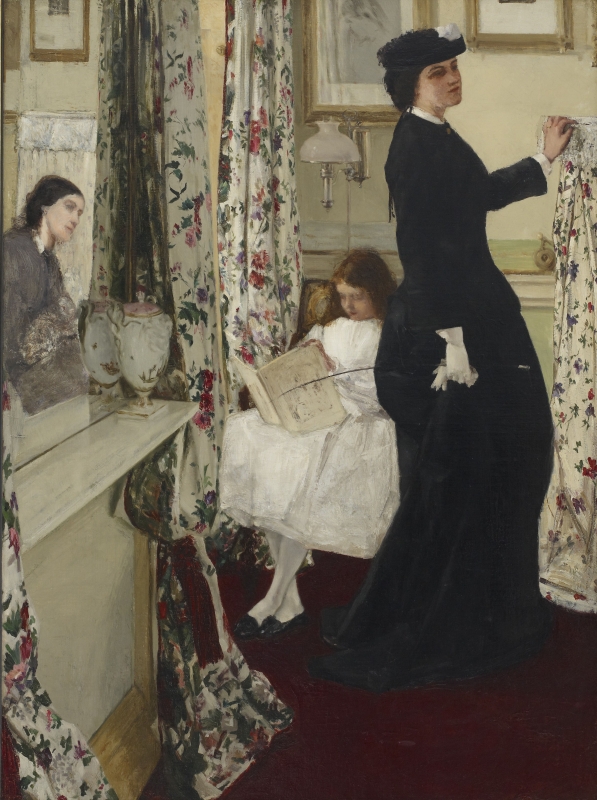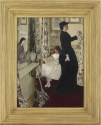Composition
X-rays of the painting show alterations to Miss Boott's hat, to Annie's head, skirt and feet, to the dado on the left and the curtain on the right. It is possible that the figure of Deborah Haden, as reflected in the mirror, was a late addition; there are signs of alterations at both the back and front of her neck, and around her hair. Behind her, the cream-coloured area that is roughly covered in vertical stripes (possibly a fireplace) seems to have been painted over a pattern like that of the long curtains to left of centre. Whistler's first intention may have been to reflect, in the mirror, the curtain that Miss Boott is holding (her hand was originally further left).
The Freer website commented, that 'Instead of trying to create a convincing illusion of three-dimensional space, Whistler adopted a color scheme and sharply angled perspective that emphasize the flatness of the picture plane.'
' 1
Technique
Overall, it was painted with fairly thick paint, applied with both brush and palette knife. Certain areas were painted carefully and with a high level of finish – the lamp over Annie's head, for instance. Others were brought to a softer, or drier, blurred finish, including the heads, hair and hat. Some large areas including the dresses and curtains, started carefully, were finished off with broad, slashing strokes of creamier paint. The paint surface is complex and textured, due to the variety of brush or knife strokes and to numerous revisions and alterations.
Conservation History
According to Bernhard Sickert (1862-1932), parts of the painting were 'badly cracked, probably from repainting' by 1905. 2
At the Freer Gallery of Art, it was cleaned, relined and resurfaced in 1921, resurfaced in 1931, and cleaned and surfaced in 1935 and 1945. The varnish was removed where it had whitened, and the painting partially cleaned, inpainted and revarnished in 1965, when it was also restretched on a new stretcher.
Condition
Some of the thickly painted and altered areas have some craquelure. The colours, however, are fresh and vivid.
Frame
- 1860/1861: style unknown, whereabouts unknown.
- After 1899: Grau-style frame, possibly American.
In preparation for the Goupil exhibition in 1892 the frame, possibly the original frame, had 'nothing done' to it. 3 The style and whereabouts of this early frame are unknown.
The current frame is in the Grau-style, and could date from the sale of the painting in 1894, or have been made in America between 1899 and 1917, when it was given to Charles Lang Freer (1856-1919) . 4
Last updated: 18th December 2020 by Margaret








